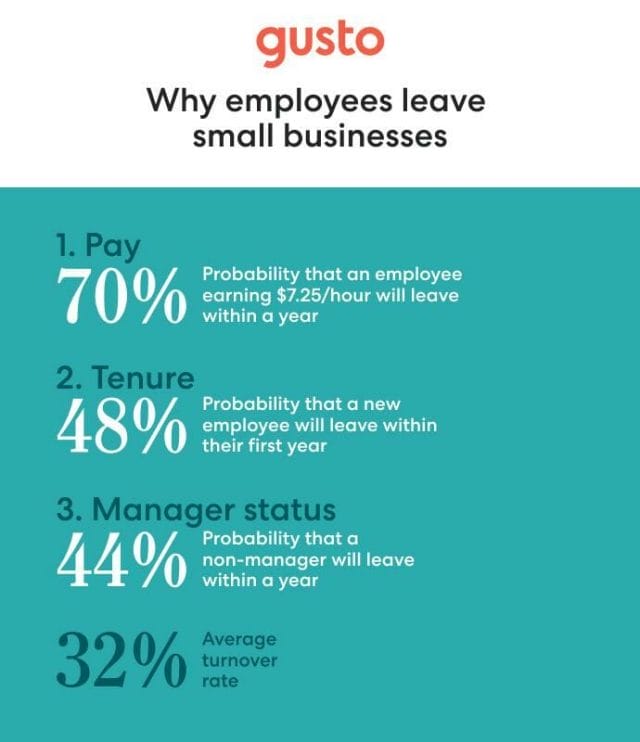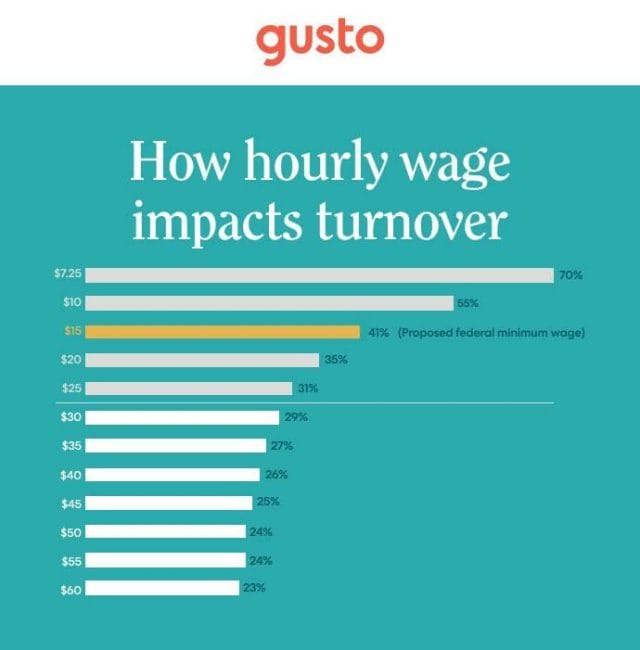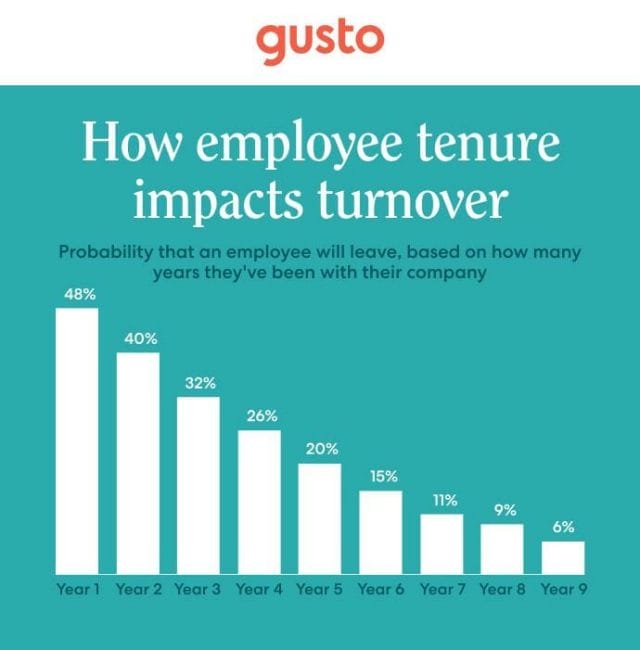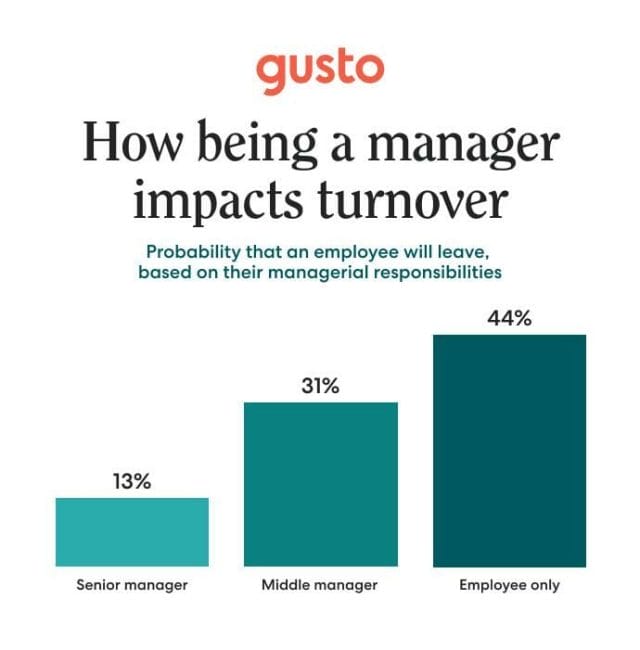This post is adapted from the blog of Gusto, a Priceonomics Data Studio customer. Does your company have interesting data? Become a Priceonomics customer.
***
Employee turnover is an expensive problem, and business owners with small teams can feel the pinch the most. Not only does your business pause when an employee leaves, but you also have to spend valuable time finding that person’s replacement.
Turnover is extremely common—and it’s also extremely preventable. By isolating the reasons why good employees leave, we can help business owners take concrete steps to reduce turnover.
Gusto is the employee system of record for more than 100,000 small businesses across the US. We recently conducted a study to better understand why employees leave for voluntary and involuntary reasons. Here’s what we found.
The three drivers of employee turnover
Across the Gusto employer base, the average company has a 32% turnover rate per year. In other words, 32% of employees quit or are terminated every year. At a 20-person business where everyone earns $50,000 a year, that 32% turnover rate can cost nearly $100,000 a year.*
In our analysis, we found that three drivers were shown to be the most predictive of turnover at small businesses:
-
Pay: For hourly employees, turnover rates level off at the $25-per-hour wage. After that wage, additional pay has a minimal effect on turnover.
-
Tenure: Newer employees have a higher turnover risk than tenured employees, particularly within the first year.
-
Managerial responsibility: Employees who manage others have a lower turnover rate than those without direct reports.

Why employees leave small businesses
1. Pay
For this analysis, we focused on hourly employees since that’s where we saw the real differences emerge. Among this group of employees, how does their chance of leaving change with different pay rates?
The following chart plots the average turnover rate at various hourly rates.

Data source: Gusto
An employee making the current federal minimum wage of $7.25 an hour has a 70% chance of leaving within a year, which is more than double the average turnover rate of 32%. It’s also nearly double the average turnover rate (41%) of someone earning $15 an hour (the new proposed federal minimum wage outlined in the Raise the Wage Act).
Takeaway: Pay becomes less of a contributing factor to turnover at around $25/hour.
2. Tenure
The chart below shows the average turnover rate by an employee’s tenure:

Data source: Gusto
Nearly half of new hires leave a business within their first year. That number drops to 40% in year two, and by the third year, it’s reduced to 32%.
Takeaway: Once employees get through the first year, they’re less likely to leave. One theory is that employees are less likely to get terminated as they prove themselves at work.
3. Managerial responsibilities
Are employees with direct reports more or less likely to leave than those who don’t manage anyone?
The following chart shows the turnover rates of three types of employees:
-
Senior managers: Employees who have a direct report, but no boss. (This group does not include business owners.)
-
Middle managers: Employees with a direct report and a boss
-
Employees only: Employees without any direct reports

Data source: Gusto
We found a strong correlation between management responsibilities and turnover. A senior manager has just a 13% turnover rate, compared to an employee without any direct reports, who is over three times more likely to leave.
Even after controlling for factors like salary and tenure, people who manage others are still more likely to stay. One theory is that senior managers are usually more invested in the team and the future of the business—which can make it harder to leave.
Takeaway: The data strongly indicate that managerial responsibilities are correlated with someone’s chance of leaving.
Three strategies that can prevent employee turnover at small businesses
Any action plan for companies that are serious about minimizing turnover should include the following:
-
Recognize that higher wages strongly correlate with lower turnover when employees are paid less than $15 per hour (the new proposed federal minimum wage).
-
Pay special attention to an employee’s first year and set them up for success.
-
Create a career ladder that involves managerial responsibility as employees add value to your business.
Let’s explore each recommendation in more detail.
1. Revisit your comp package
The more you pay your employees, the lower your turnover rate—until a certain point. This finding is particularly important if you have employees with hourly rates of $25 and below. After that benchmark rate, additional compensation results in only a slightly lower turnover rate.
However, not every business owner can easily bump up their team’s pay.
Here are a few other best practices that can help you prevent employees from leaving because of non-competitive pay:
-
Set a salary for yourself that’s reasonable and meaningful. Revisiting your own salary will help you be better prepared as you figure out compensation for other people on your team.
-
Do competitive research so you can be sure your compensation package is meaningful to new hires—and sets you apart from other companies.
-
Don’t ask about salary history: Make sure asking about a candidate’s salary history isn’t a part of your hiring process, so you’re following the law and staying unbiased.
-
Brush up on the latest minimum wage laws for your city and state so you can be sure you’re compliant.
2. A meaningful employee onboarding program
The first year is a danger zone. During this timeframe, employees leave companies at roughly the same rate at which they stay.
Onboarding programs aimed at making first-year employees successful can pay immediate dividends in reducing employee turnover. Too often, onboarding programs focus mostly on the immediate requirements—like filling out a W-4—and not enough on training that sets employees up for success.
Below are a few resources to help you set up a better onboarding program:
-
Personalize your program: Use the information you learned about your new hire throughout the interview process—whether it’s from a reference check or the candidate themselves—to inform how you onboard them. For example, if a candidate learns better by doing, give them a project to start on right away.
-
Use an employee onboarding checklist to be sure you don’t forget any key compliance steps along the way.
-
Create an employee handbook that makes it easy for new employees to understand your company’s policies, mission, and what you expect from them.
-
Stay on top of best-in-class examples: Get inspired by these pro tips from companies with thoughtful onboarding programs.
And while you should never take your most tenured employees for granted, it’s nice to know they’re more likely to stay at your business.
This is an opportunity to keep them engaged through career development plans that help them grow, thoughtful promotions and bonuses, and making sure their compensation packages stay competitive.
3. Pay attention to career growth
While we don’t advise giving someone management responsibility before they’re ready, it’s clear that company leaders have some of the lowest turnover rates.
In practice, that means you should be on the lookout for high-potential employees, since an employee with managerial responsibility is less likely to leave their current company. Not only does leading others contribute to tenure, but expanding your management team might also help if you’re struggling to keep everyone in flying formation.
Here are a few more suggestions that you can incorporate in your business:
-
Conduct regular performance reviews that give employees tangible next steps for how they can progress in their careers.
-
Give potential managers opportunities to prove their abilities to lead others, whether it’s having them manage an intern or owning a new project or process end-to-end.
-
Identify the managers within your business instead of kicking off an outside search.
-
Promote employees who have management potential vs. employees who are good at what they do, but lack the skills or interest in leading people.
In this analysis, we’ve found that pay, employee tenure, and management responsibility are the three biggest indicators of turnover at small businesses. They’re also three things that business owners can actually do something about.
While the strategies identified in this article aren’t free, they’re still worth considering and experimenting with. Because investing in these areas can be more cost-effective than having your best employee walk out the door for a reason you could have easily fixed.
Methodology
We looked at anonymized data among tens of thousands of Gusto employers across the United States from a diverse set of industries, geographies, and business sizes. The goal was to see how many employees that were employed at a business on January 1, 2018 left at some point during that year, either for voluntary or involuntary reasons. We were then able to segment the data by tenure, pay, and management responsibility to unpack the circumstances that contribute to employee turnover.
*Based on the Work Institute 2018 Retention Report, which calculated that turnover costs can equal 33% of a person’s salary.
***
Note: If you’re a company that wants to work with Priceonomics to turn your data into great stories, learn more about the Priceonomics Data Studio.




